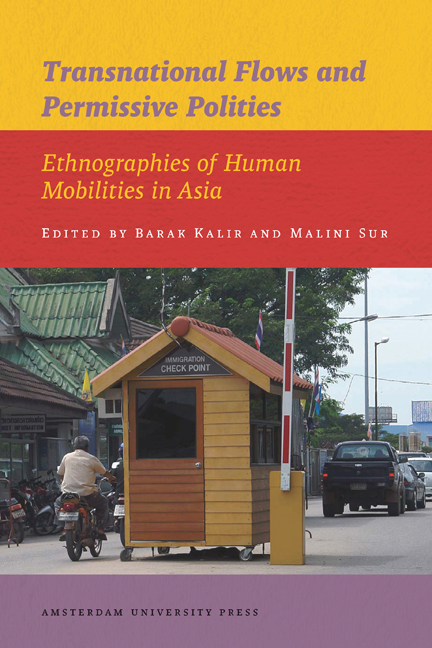Book contents
- Frontmatter
- Contents
- List of Tables, Maps, Figures and Photographs
- Acknowledgements
- Introduction: Mobile Practices and Regimes of Permissiveness
- 1 Illegality Rules: Chinese Migrant Workers Caught up in the Illegal but Licit Operations of Labour Migration Regimes
- 2 Contesting the State of Exception in the Afghan-Pakistani Marchlands
- 3 ‘Looking for a Life’: Rohingya Refugee Migration in the Post-Imperial Age
- 4 Smuggling Cultures in the Indonesia-Singapore Borderlands
- 5 Trade, Transnationalism and Ethnic Infighting: Borders of Authority in Northeast Borneo
- 6 Bamboo Baskets and Barricades: Gendered Landscapes at the India-Bangladesh Border
- 7 Moving between Kerala and Dubai: Women Domestic Workers, State Actors and the Misrecognition of Problems
- 8 Emigration of Female Domestic Workers from Kerala: Gender, State Policy and the Politics of Movement
- 9 Mainland Chinese Migrants in Taiwan, 1895-1945: The Drawbacks of Being Legal
- 10 ‘Playing Edge Ball’: Transnational Migration Brokerage in China
- Epilogue: Irregular Mobilities and Disjunctive Moralities
- About the Editors and Contributors
- Bibliography
- Index
- Publications Series
9 - Mainland Chinese Migrants in Taiwan, 1895-1945: The Drawbacks of Being Legal
Published online by Cambridge University Press: 15 January 2021
- Frontmatter
- Contents
- List of Tables, Maps, Figures and Photographs
- Acknowledgements
- Introduction: Mobile Practices and Regimes of Permissiveness
- 1 Illegality Rules: Chinese Migrant Workers Caught up in the Illegal but Licit Operations of Labour Migration Regimes
- 2 Contesting the State of Exception in the Afghan-Pakistani Marchlands
- 3 ‘Looking for a Life’: Rohingya Refugee Migration in the Post-Imperial Age
- 4 Smuggling Cultures in the Indonesia-Singapore Borderlands
- 5 Trade, Transnationalism and Ethnic Infighting: Borders of Authority in Northeast Borneo
- 6 Bamboo Baskets and Barricades: Gendered Landscapes at the India-Bangladesh Border
- 7 Moving between Kerala and Dubai: Women Domestic Workers, State Actors and the Misrecognition of Problems
- 8 Emigration of Female Domestic Workers from Kerala: Gender, State Policy and the Politics of Movement
- 9 Mainland Chinese Migrants in Taiwan, 1895-1945: The Drawbacks of Being Legal
- 10 ‘Playing Edge Ball’: Transnational Migration Brokerage in China
- Epilogue: Irregular Mobilities and Disjunctive Moralities
- About the Editors and Contributors
- Bibliography
- Index
- Publications Series
Summary
In Taiwan, a population of migrant workers from mainland China came into being during the period when the Japanese colonial regime was in power, from 1895 to 1945. In the 1930s, their numbers rose to at least 60,000. These migrants worked and lived in the rapidly developing big cities of Taiwan, where they supplemented the labour market. Before the Japanese occupied the island, migrants from mainland China had worked and settled continually in Taiwan over a period of more than two centuries. This had never given rise to problems concerning their legal status, because they remained subjects of the Chinese empire just as they had been on the mainland. After 1895, however, the Japanese occupation caused them to suffer from the contradictions inherent in the legal status that the colonial regime imposed on them. This was in the first place because the migrants were officially categorised as foreigners without a right to acquire citizenship rights, whereas in actual fact they were in the process of settling permanently, as their predecessors had tended to for centuries. As a consequence, they did not acquire access to state resources which their actual status would have justified. Furthermore, they were also more easily discriminated against and exploited. Their categorisation as foreigners was defective for yet another reason. Most of the migrants came from the same districts in the Fujian and Guangdong provinces in South China from where the native Taiwanese also hailed from, and were linguistically and culturally close to the latter. Often, they also had family or friendship ties with them. Therefore, Chinese immigrant workers were only foreigners in the strictly political and legal sense of the word.
For both reasons, the Taiwanese colonial immigration regime is a good example of one central object of research in this book – namely how states may represent and categorise people in a certain way but ‘fail to capture the very phenomena they manifestly aim to order’ (see introduction). By allowing the migrants to stay on despite their formal temporary status, the Japanese colonial state created a ‘regime of permissiveness’ for the migrants, which in turn generated a ‘zone of licitness’ for them in Taiwanese society (see introduction). It would not be precise to say that this ‘zone of licitness’ was located outside the law in a literal sense because the migrants’ presence in Taiwan in itself was formally legal.
- Type
- Chapter
- Information
- Transnational Flows and Permissive PolitiesEthnographies of Human Mobilities in Asia, pp. 189 - 206Publisher: Amsterdam University PressPrint publication year: 2012
- 2
- Cited by

